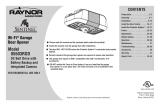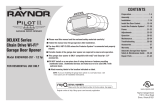
2
When you see this Signal Word on the following pages, it will alert you to the possibility of damage to your garage
door and/or the garage door opener if you do not comply with the cautionary statements that accompany it.
Read them carefully.
WARNING: This product can expose you to chemicals including lead, which are known to the State
of California to cause cancer or birth defects or other reproductive harm. For more information go to
www.P65Warnings.ca.gov
Unattended Operation
The Timer-to-Close (TTC) feature, and the myQ® App are examples of unattended close and are to be used ONLY
with sectional doors. Any device or feature that allows the door to close without being in the line of sight of the
door is considered unattended close. The Timer-to-Close (TTC) feature, the myQ® App, and any other myQ®
devices are to be used ONLY with sectional doors.
The images throughout this manual are for reference only and your product
may look different.
Safety Symbol and Signal Word ReviewContents
Preparation ...................................................................................................................................... 3
Assembly.......................................................................................................................................... 7
Installation ....................................................................................................................................12
Install the Door Control ............................................................................................................22
Install the Protector System® ...................................................................................................24
Connect Power ......................................................................................................................... 28
Adjustments ..................................................................................................................................30
Battery Backup .............................................................................................................................33
myQ® App Control .........................................................................................................................34
Connect With Your Smartphone ..............................................................................................34
Camera ...........................................................................................................................................35
Operation .......................................................................................................................................36
Using your Garage Door Opener ..............................................................................................36
Motion Detecting Control Panel ..............................................................................................37
Remote Control and Keyless Entry ...........................................................................................38
HomeLink® ................................................................................................................................38
Erase the Memory .....................................................................................................................39
To Open the Door Manually......................................................................................................39
Maintenance .................................................................................................................................40
Troubleshooting ............................................................................................................................41
Warranty ........................................................................................................................................43
Automatic Garage Door Opener Safety & Maintenance Guide ................................................44
Repair Parts ...................................................................................................................................46
Rail Assembly Parts ..................................................................................................................46
Installation Parts ......................................................................................................................46
Model B4603TC ........................................................................................................................47
Model B4613TC ........................................................................................................................48
Model B4643TC ........................................................................................................................49
Models B6713TC , and B6753TC.............................................................................................50
This garage door opener has been designed and tested to offer safe service provided it is installed, oper ated,
maintained and tested in strict accordance with the instructions and warnings contained in this manual.
Mechanical
Electrical
When you see these Safety Symbols and Signal Words on the following pages, they will alert you to the
possibility of serious injury or death if you do not comply with the warnings that accompany them. The
hazard may come from something mechanical or from electric shock. Read the warnings carefully.
























